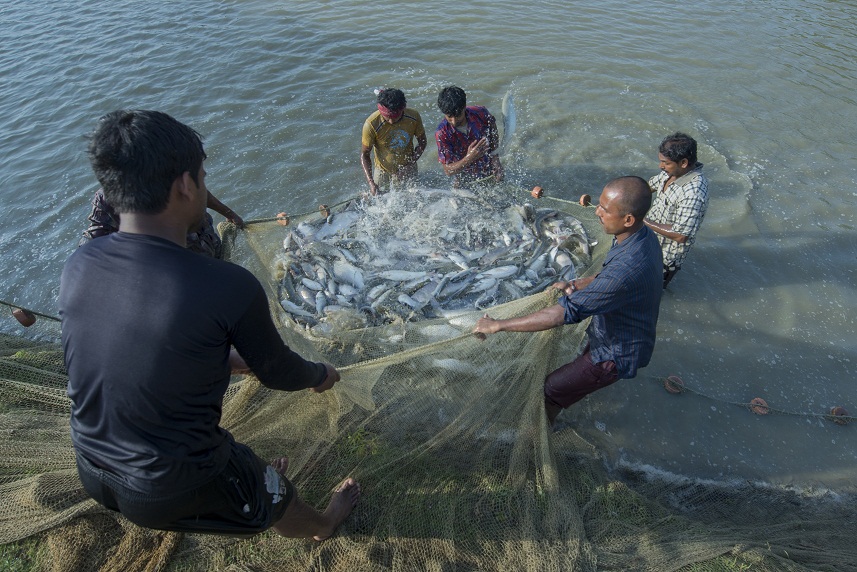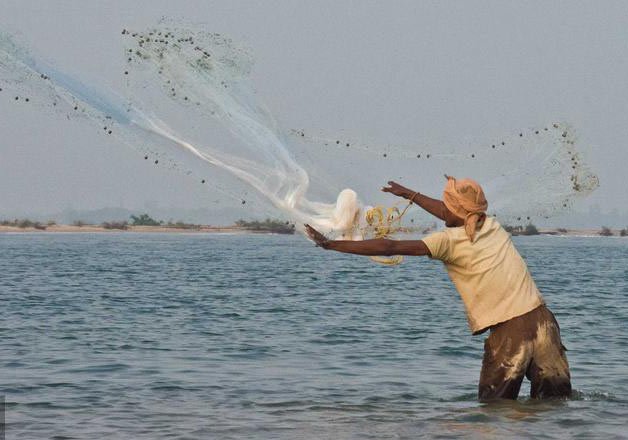Fish like singhi, magur, tangra, bata and koi lay eggs in freshwater lakes and rivers during the rainy season, and these tasty species also happen to be some of the favourites among Bengalis.
However, many fishermen illegally use mosquito nets to catch fish, and in the process also snare the eggs in the nets. Unable to hatch, fish production gets hampered.
Secondly, during the rainy season, pesticides used in paddy fields flow with the water to these freshwater areas. This also kills many hatchlings and destroys eggs.
The insecticides also kill certain microorganisms which form a primary food source for the fish. Lack of this food causes the fish to develop diseases. Fish production gets affected for this reason too.
To normalise as well as increase the production of fish, the Bengal Fisheries Department is releasing hatchlings in the water bodies across the State during this rainy season. Alongside this, awareness programmes are being conducted to tell people about the ill-effects of using mosquito nets to catch fish, and also about the negative effects of pesticides overuse.
The increased, healthy production of these natural inhabitants of freshwater bodies will also help in preserving the ecological balance of the State.
Source: Bartaman
দেশি কই, শিঙি-মাগুর, ট্যাংরা, বাটা মাছের উৎপাদন বাড়াতে উদ্যোগী রাজ্য সরকার
যে জলাশয়ে কল জল থাকে, সেখানে দেশি কই, শিঙি-মাগুর, ট্যাংরা, বাটা মাছ বর্ষায় ডিম পাড়ে। কিন্তু সচেতনতার অভাবে অবাধে মশারি জাতীয় নেট ব্যাবহার করে মাছ ধরা হয়। এর ফলে সমস্ত ডিম নষ্ট হয়ে যাচ্ছে।
দ্বিতীয়ত, ধান চাষ এবং অন্যান্য সবজি চাষের জমিতে রাসায়নিকের ব্যাবহার বেড়েছে। বর্ষার সময় জমির জল গিয়ে পড়ছে ওইসব জলাশয়ে। এতে এই সকল প্রাকৃতিক মাছের ‘ব্রিডিং গ্রাউন্ডের’ ক্ষতি হচ্ছে। তাছাড়া, এই রাসায়নিকের প্রভাবে ডিম এবং ডিমপোনার মৃত্যু হচ্ছে। আগে ধানচাষের জমিতেও এই ধরনের মাছের জন্ম হত।
তৃতীয়ত, জলাশয়ে এক ধরনের জলজ জীব এবং উদ্ভিদ তৈরি হয়। এই মাছেদের ওটাই প্রধান খাবার। কিন্তু, রাসায়নিকের জেরে সেই সকলও তৈরি হচ্ছে না। এতে, খাদ্য সঙ্কট দিচ্ছে।
পাশাপাশি মাছের গায়ে বিভিন্ন ধরনের রোগ হচ্ছে। তার জেরেই মৃত্যু হচ্ছে ডিমপোনার। চতুর্থত, এখন মাছ ধরার কৌশল আধুনিক হয়েছে। কোনও মাছই নেট ভেদ করে বের হতে পারে না। ফলে, এই মাছের ডিমপোনাও নষ্ট হয়ে যাচ্ছে।
এইসকল সচেতনতার অভাবেই হারিয়ে যেতে বসেছে বাংলার দেশি কই, শিঙি-মাগুর, ট্যাংরা, বাটা মাছ। এই ধরনের মাছ বাঁচিয়ে রাখতে রাজ্য মৎস্য দপ্তরের পক্ষ থেকে চলতি বর্ষায় প্রতিটি জেলায় এই দেশীয় প্রাকৃতিক জলের মাছের ডিমপোনা ছাড়ার সিদ্ধান্ত নেওয়া হয়েছে। এই কর্মকাণ্ডে সাধারন মানুষকেও উৎসাহিত করার পাশাপাশি রাজ্যজুড়ে প্রচার অভিযানও শুরু হয়েছে। চলছে সচেতনতা অভিযানও।
মৎস্যদপ্তর সূত্রে জানা গিয়েছে, আগে এই দেশীয় প্রাকৃতিক মাছের কদর ছিল না, ফলে দামও কম ছিল। কিন্তু, এখন উৎপাদনের পরিমাণ কমে যাওয়ায় চাহিদা ও দাম দুই বেড়েছে। রুই, কাতলা, মৃগেল ছাড়াও কই, মাগুর, ট্যাংরা, শিঙি, বাটা প্রভৃতি দেশীয় প্রাকৃতিক মাছের ডিমপোনাও ছাড়া হয়েছে এবার। এই ধরনের মাছ জলাশয়ের বাস্তুতন্ত্র রক্ষার ক্ষেত্রেও গুরুত্বপূর্ণ ভূমিকা পালন করে।



